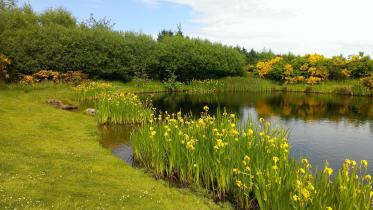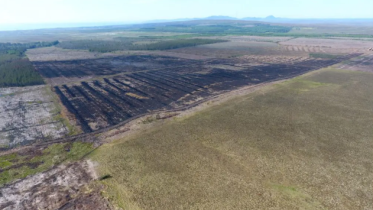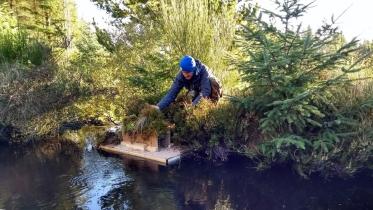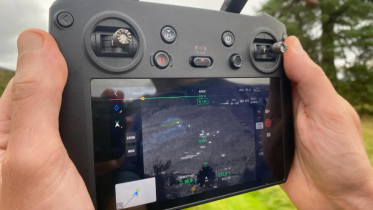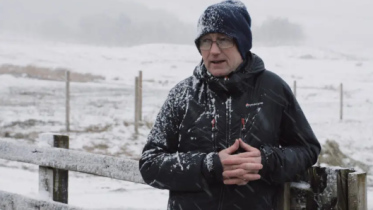NatureScot Research Report 1295 - Youth Survey on NatureScot’s Corporate Plan 2022-2026
Year of publication: 2022
Authors: Gardner. A. and Webster. C. 2022.
Cite as: Gardner. A. and Webster. C. 2022. Youth Survey on NatureScot’s Corporate Plan 2022-2026. NatureScot Research Report No. 1295.
Keywords
young people; participation; barriers; eco-anxiety; Corporate Plan
Background
NatureScot’s Youth Survey on the Corporate Plan 2022-2026 was launched to survey young people’s views on nature in Scotland. It was undertaken to ensure the Corporate Plan 2022-26 is more reflective of the young people's wants for nature and takes proper account of their concerns. It is supported by a review of youth statements, manifestos and declarations that provide positions on nature and climate change from young people across Scotland.
A total of 113, self-selecting, young people (11-30 years old) across Scotland responded, with a fairly representative spread of age, gender identity, geography, race, and (dis)ability.
The survey asked questions regarding what a nature-rich Scotland looks like to young people, their ability to contribute to this vision, what the barriers are to achieving this, and how NatureScot could help overcome these barriers.
Main findings
- When asked what their vision for Scotland’s nature in 2030, a range of futures were noted, with some expressing more ambition than others. Pictures were painted of a dynamic, restored and resilient Scotland, teeming with biodiversity, where nature is accessible to all, and people and nature are one and the same. At the same time, eco-anxiety, stemming from concerns regarding the climate emergency and biodiversity loss, was expressed by a significant number of respondents.
- Of the Corporate Priorities, nature-based solutions, marine protected areas, and increased funding for restoration projects ranked most important to young people. The least important priorities were the development and sharing of ecological data and establishing a new National Park. A number of gaps were identified by the young people with the most notable being: monitoring and enforcement and NatureScot leading the cultural shift needed for increased nature connectedness and behaviour change within society.
- Under half of respondents felt that they were able to contribute to Scotland’s nature-rich ambition, and over half felt there are barriers to young people’s involvement in contributing to a nature-rich future.
- Most recorded barriers included barriers to skills and jobs, individual effort not being enough, finances, unaware of how to help, accessibility and lack of youth voice and limited opportunities outside of employment.
- Respondents suggested a number of ways in which NatureScot and others can help reduce these barriers including public education and behaviour change, jobs and career information, providing opportunities for young people to have a voice, and creation and promotion of opportunities outside of employment.
Acknowledgements
Firstly, NatureScot would like to thank all the young people who gave their time and energy to input to the survey and gave us such valuable insight into what young people think and experience.
We’d also like to thank the NatureScot Young Employee Panel for helping to create the survey questions and to our partners and individuals who helped to disseminate the survey across Scotland.
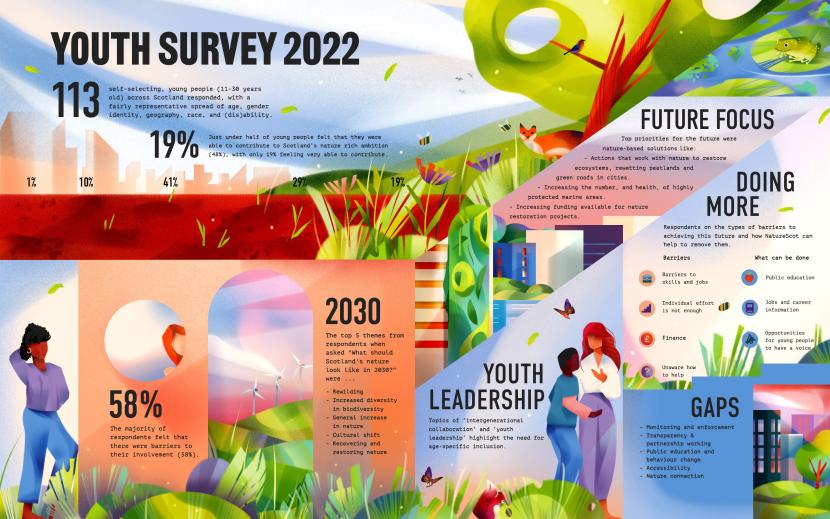
Illustration of the key findings from the report as PDF
Key findings in illustration;
- 113 self-selecting, young people (11-30 years old) across Scotland responded, with a fairly representative spread of age, gender identity, geography, race, and (dis)ability.
- Just under half of young people felt that they were able to contribute to Scotland's nature-rich ambition (48%), with only 19% feeling very able to contribute.
- The top 5 themes from respondents when asked "What should Scotland's nature look like in 2030?" were rewilding, increased diversity in biodiversity, a general increase in nature, cultural shift, and recovering and restoring nature
- The majority of respondents felt that there were barriers to their involvement (58%)
- Top priorities for the future were nature-based solutions like actions that work with nature to restore ecosystems, rewetting peatlands and green roofs in cities, increasing the number and health of highly protected marine areas, and increasing funding available for nature restoration projects.
- Respondents identified the following barriers to achieving this future; barriers to skills and jobs, individual effort is not enough, finance, and unaware of how to help.
- respondents identified the following ways in which NatureScot could help remove these barriers; public education, jobs and career information, and opportunities for young people to have a voice.
- Topics of intergenerational collaboration and youth leadership highlight the need for age-specific inclusion.
- Gaps included monitoring and enforcement, transparency and partnership working, public education and behaviour change, accessibility, and nature connection.
Executive summary
NatureScot’s Youth Survey on the Corporate Plan 2022-2026 was launched to survey young people’s views on nature in Scotland. It was undertaken to ensure the Corporate Plan 2022-26 is more reflective of the young people's wants for nature and takes proper account of their concerns. It is supported by a review of youth statements, manifestos and declarations that provide positions on nature and climate change from young people across Scotland.
A total of 113, self-selecting, young people (11-30 years old) across Scotland responded, with a fairly representative spread of age, gender identity, geography, race, and (dis)ability.
The survey asked questions regarding what a nature-rich Scotland looks like to young people, their ability to contribute to this vision, what the barriers are to achieving this, and how NatureScot could help overcome these barriers. The responses were analysed and labelled with reoccurring themes. Below is the list of the most recorded themes for each topic, with full list of themes, and their occurrence, found in the full report.
NatureScot’s focus
To young people in Scotland, a thriving, nature-rich Scotland in 2030 includes, but is not limited to, the following features:
- Rewilding
- Increased diversity in biodiversity
- General increase in nature
- Cultural shift in nature connection
- Recovering and being restored
- Accessible and available
- Species re-introduction
- Cleaner
Top priorities, taken from the list of priorities being explored in the development of the Corporate Plan, for young people were nature-based solutions, marine protected areas, and increased funding for restoration projects. The least important priorities were the development and sharing of ecological data and establishing a new National Park.
The young people were asked to identify any areas of work they felt were missing from the list of priorities. The gaps identified with the most incidences recorded were:
- Monitoring and enforcement
- Transparency and partnership working
- (Public) education and behaviour change
- Nature connectedness
- Accessibility (physical and diversity & inclusion)
- Species reintroduction and rewilding
- Delivery, accountability and leading by example
While some of these elements are included in the priorities, it was felt that they were not prominent enough.
Youth participation
As Scotland’s Nature Agency, we want to ensure that everyone, including all young people, feel empowered and able to take action for a nature-rich future. Of the young people who responded, just under half felt that they were able to contribute to Scotland’s nature-rich ambition, with only 19% strongly feeling that they can personally do so. 52% felt they were less confident or unable to contribute.
It is also important to know what barriers young people believe limit their ability to contribute to achieving their 2030 vision of nature. Over half of respondents (58%) felt there are barriers to young people’s involvement in contributing to a nature-rich future. Top recorded themes were:
- Barriers to skills and jobs
- Believing individual effort is not enough
- Finance
- Being unaware of how to help
- Accessibility (physical and diversity & inclusion)
- Lack of youth voice
- Lack of opportunities and engagement
- Time
While not specifically identified by respondents as a barrier, evidence of eco-anxiety was noted across the survey results. Eco-anxiety is 'distress caused by ecological and environmental degradation' - particularly the lack of action to tackle it. This was seen when respondents were asked to envision a nature-rich future, and when identifying barriers (mostly recorded in responses classed as 'believing individual effort is not enough'). Some respondent’s trust in older generations’ abilities, and particularly in organisations, such as NatureScot, is so damaged that they report a distrust or disbelief in the ability to achieve a nature-rich future at all.
Respondents were also asked to provide suggestions for what NatureScot could do to help remove the barriers. Most recorded themes were:
- (Public) education and behavioural change
- Jobs and career information
- Opportunities for young people to have a voice
- Creation and promotion of opportunities
- Equitable and accessible solutions
- Leadership and influence
It is clear that the young people who responded share an ambitious vision for the future of Scotland’s nature. One which all people are very much a part of. This is supported by the findings in the youth statements review. It is generally agreed that the majority of the draft Corporate Plan 2022-2026 priorities are very important for achieving their 2030 vision, however there were a number of gaps that were identified that need further consideration. The most notable of these gaps were, monitoring and enforcement and NatureScot leading the cultural shift needed for increased nature connectedness and behaviour change within society. The majority of young people said that they feel unable to contribute to this nature-rich future, despite wanting to. Key barriers preventing them from doing so, included issues around jobs and opportunities for meaningful engagement, and accessibility including finances, time, and other diversity and inclusion aspects.
Introduction
Purpose
As part of wider stakeholder engagement on the development on NatureScot’s 2022-2026 Corporate Plan, NatureScot endeavoured to gather the views of Scotland’s young people to help align the ambitions of NatureScot with that of Scotland’s young people.
A key driver for undertaking this research is the recognition that tackling climate change and biodiversity loss will require increased effort to engage the public and work proactively with a range of stakeholders, particularly those currently under-represented in environmental decision-making. As the Global Biodiversity Framework makes clear, addressing these challenges “will require a participatory and inclusive whole of society approach that engages actors beyond National Governments, including……NGO’s, indigenous peoples and local communities, women’s groups, youth groups,….faith based organisations,….citizens at large, and other stakeholders.” (UN Convention on Biological Diversity Secretariat, 2021).
While the primary purpose for this research was to feed into the development of the 2022-2026 Corporate Plan, the views and opinions of the young respondents have wider implications for a range of NatureScot work. This includes future delivery plans, its Youth Engagement Action Plan and equalities duties and mainstreaming agenda (NatureScot, 2021), Nature-based Skills and Jobs Action Plan and stakeholder input into the new Scottish Biodiversity Strategy. There is also hope that the results will help inform partner organisations’ own priorities and work, particularly when engaging with young people. In promoting the results of this survey, we also hope it will help inform partner organisations’ own priorities and work, particularly when engaging with young people.
Youth engagement in environmental decision-making
Decisions on our natural environment and biodiversity today are going to have long-term consequences that not only affect current generations, but future generations too. Over the last few years there has been increased awareness of the role of young people in the twin crises of climate change and biodiversity loss. Young people are not only tomorrow’s leaders, but have made great efforts to be seen as today’s leaders.
Current methods of consultation, stakeholder engagement, decision-making and governance have been shown to present barriers to many groups in society including young people (Decent Jobs for Youth and Generation Unlimited, 2020). Young people in Scotland are also impacted by negative stereotypes which stigmatise young people. A Scottish survey found 24% of respondents viewed young people as lazy, 39% thought they lacked communication skills and 35% said young people do not take responsibility for their actions (Scottish Government, 2017). Amongst others, young people are therefore an underrepresented stakeholder group in many environmental decision-making processes that experience stigmatisation based on their protected characteristic. Barriers young people identified include: time, finances, lack of built-in formalised processes, language, and awareness.
Methodology
Two separate approaches were undertaken:
- A review of known published youth statements concerning nature and climate change particularly those developed in the run up to, and over the period of, COP26;
- A survey, designed by NatureScot’s young employees.
To help frane and support the NatureScot Youth Survey on the Corporate Plan, a review of six youth statements (including positions, manifestos and declarations) concerning nature and climate change was conducted. These included both international and national statements, a full list of which can be found in Annex 1 - Youth statement review.
The survey was designed by NatureScot's young employees, and hosted online using Microsoft Formsfor three weeks during November/ December 2021. The survey was well publicised through the NatureScot social media channels as well as distributed to partners, particularly targeting youth networks.
Both the youth statements and the survey’s open-ended question responses were coded into key themes.
Review of Youth Statements
The content analysis of the youth statements resulted in the below key themes (Table 1), many of which are reflected in the survey results.
Table 1. Key themes that appeared in the youth statements and the number of times that theme appeared. A full list of themes can be found in Annex 1 - Youth statement review.
|
Theme |
Incidence |
|---|---|
|
Intersectionality and environmental justice |
45 |
|
Collaboration, collective action |
22 |
|
Accountability and transparency |
21 |
|
Funding, finance, and spending |
18 |
|
Indigenous and local communities and knowledges |
18 |
|
Biodiversity |
15 |
|
Education |
15 |
|
Creativity and innovation |
13 |
|
Community self-sufficiency, action, and leadership |
11 |
|
Intergenerational collaboration and legacy |
10 |
|
Youth leadership |
10 |
|
Nature connectedness |
10 |
|
Urban green space and infrastructure |
10 |
|
Climate change |
10 |
|
Immediate action |
10 |
|
Government action |
10 |
The theme of ‘biodiversity’ was prevalent throughout the youth statements with repeated emergence in both those regarding nature and climate. Other strong themes included discussions of equality, environmental and climate justice, access and accessibility, finance and spending, nature connection, collaboration, and education. These themes of Diversity and Inclusion are key concerns for young people. Topics of ‘intergenerational collaboration’ and ‘youth leadership’ highlight the need for age-specific inclusion. Themes of eco-anxiety and solastalgia also appeared in the analysis. Eco-anxiety and solastalgia refer to emotional or existential distress caused by ecological and environmental degradation, particularly the lack of action to tackle it (Hickman et al., 2021), and the feeling of distress associated with a loss of a sense of place, respectively. They can be understood as feelings of fear, anger or powerlessness. In the statement reviews, these were noted through mentions of ‘immediate action’ and ‘government action’, with eco-anxiety leading to calls for urgent action, particularly urgent government action.
The analysis of these statements echo many of the findings from the survey detailed below. This close alignment suggest that the survey results reflect commonly shared concerns and priorities from other groups of young people in Scotland and beyond. The survey also uniquely contributes detailed qualitative data specifically tailored for incorporation in NatureScot’s Corporate Plan.
Survey
A total of 113 young people (11-30 years old) from across Scotland responded. There was a relatively even split in the age of respondents with a slight majority (31%) in the 21-25 category. Females responded (62%) twice that of males (31%) and 4% identified as non-binary. There could be a number of reasons for this overrepresentation of female respondents, however, it worth noting that it has been found that females are more likely to complete surveys than males (Smith., 2008; Sax et al., 2003). The majority of respondents classified themselves as white (90%) with the remaining identifying as Asian or being of mixed ethnicity, or preferred not to say. 12% identified as having a disability. There is good geographical representation, with respondents from every district with the exception of the Outer Hebrides and the Shetland Islands. This is fairly reflective of Scotland’s population bar the overrepresentation of females. A full breakdown of respondent demographics can be found in Annex 2 - Survey respondents’ demographics.
The respondents were self-selecting and therefore are likely to represent a portion of the youth population who are already fairly engaged in nature and, possibly, with NatureScot. Therefore, the responses are not representative of the views of all young people in Scotland but rather a group of young people who already have a potential interest in nature and in the work NatureScot undertakes.
The survey presented questions asking young people to tell us what they envisioned nature to look like, the importance of various nature priorities, and their perceived ability to participate in achieving a nature-rich future. Themes have been created for each of the questions, with most prevalent themes explored below and details of all themes found in Annex 3 - Full survey results.
NatureScot’s Focus
What should Scotland's nature look like in 2030?
To begin, the young people were asked to envision what nature in Scotland should look like in 2030. The end of this decade is seen as a key turning point from biodiversity loss, towards a nature-rich future, by many such as the Nature Positive 2030 from the UK Nature Agencies and the G7 2030 Nature Compact.
Within the young peoples’ responses, a range of futures were noted, with some expressing more ambition than others. Pictures were painted of a dynamic, restored and resilient Scotland, teeming with biodiversity, where nature is accessible to all, and people and nature are one and the same. Table 2 lists the highest occurring themes:
Table 2. Highest occurring themes from respondents when asked 'What should Scotland's nature look like in 2030?' Full list of themes, plus descriptions, found in Annex 3 - Full survey results.
|
Theme |
Incidence |
|---|---|
|
Rewilding |
39 |
|
Increased diversity in biodiversity |
26 |
|
General increase in nature |
25 |
|
Cultural shift |
22 |
|
Recovering and being restored |
18 |
|
Accessible and available |
18 |
|
Species re-introduction |
15 |
|
Cleaner |
13 |
|
Nature-based solutions |
13 |
|
Urban nature and Green Infrastructure |
12 |
|
Climate change |
11 |
|
Range of natural spaces |
11 |
|
Prioritised in business, policy and funding |
11 |
|
Protected areas and protected species |
10 |
Many respondents discussed the ecological and environmental aspects of a nature-rich future with rewilding and biodiversity mentioned often, with particular reference to a recovering and restored nature, where ecosystem health, resilience and connectivity are prominent. For example, one respondent imagined that:
"...Birds would return to cities with the new abundance insects as a food source and fill the streets with colour and birdsongs. The countryside would no longer consist of large monocultures pumped full with pesticides and fertilisers but would become a dazzling patchworks of agro-forests, small fields and hedges, teeming with wildlife. Government funds would be redistributed to ensure more people could work in the countryside to create this landscape and be paid well..."
‘Increased diversity in biodiversity’ was often related to re-introducing species. In the survey, this was mainly discussed in relation to keystone (an organism that helps define an entire ecosystem), predatory animals, such as lynx and wolves, but also referred to plant life and Invasive Non-Native Species:
“Re-introduction of top predators such as lynx and wolves to control herbivore numbers. Removal of invasive non-native species.”
This view of a nature was shared by older young people and younger people alike:
"I think Scotland’s nature should have diversity, lots of different plants and animals, abundant forests, lively rivers and lots of colour everywhere you look..."
This emphasis on the beauty of nature was extended through the theme of general increase in nature. Young people want to be able to see this beauty in a variety of places, for it to be ubiquitous:
"It [Scotland’s nature] is already so beautiful, but I would love to see more flowers and vibrancy in more urban areas like Glasgow."
The inclusion of people was also mentioned extensively, particularly in highlighting that achieving this abundance of nature requires, what respondents identified as, a ‘cultural shift’. This shift often referenced the need to shift to a culture that values, respects, and appreciates nature. This also included seeing humans as caring for nature, not just as a responsibility, but because it was something people want to do. Many identified the need to close the nature-human divide, with a focus on nature connection (the relationship between people and the rest of nature) and coexistence between humans, plants, and animals as different axes of the same broad concept of ‘nature’. For example, the sentiment of a connection can be seen in the following quote:
"We will have gone a long way to mending the rift between people and nature- the cultural lie that lets us act as if we aren't inextricably linked to all other life. Nature will be integrated into how we live our lives- our homes, our neighbourhoods, where we grow our food, how we educate ourselves, how we collectively cope with the massive turmoil of living at this point in human history...I'd go even further and say we will no longer see the world as an all you can eat buffet of resources laid out before us, only valuable in so far as it can stop our homes flooding, or boost our mood or maybe, just maybe, grow us out of this hole we've dug. We might, instead see it as it is-as our home, our family."
This idea, of seeing nature as “our home, our family”, is mirrored in the Youth #ForNature to #StopTheSame Manifesto. They noted a similar sentiment of harmony and coexistence:
“"This Letter outlines priorities that young people feel must be addressed to set humanity on course for achieving the 2050 vision of “living in harmony with nature”, agreed by world leaders in the Convention on Biological Diversity (CBD).”
A want for a biodiverse natural world, alongside seeing people as part of nature, ties in with another of the key themes identified. It is noted that there are still significant issues regarding which bodies are valued in such discussions and which are excluded. This becomes apparent when we see which spaces are essentially taken from particular peoples, referenced in the youth statement reviews as ‘intersectionality and environmental justice’ and ‘Indigenous and local rights and knowledges’, and ‘available and accessible’ in the survey responses:
“…before I was severely disabled, I loved to go on long walks. I loved going to forests, rivers, mountains, anywhere, especially [sic] if it looked like it was from a mythical fairy tale, which Scotland is well know [sic] for landscapes like that!
Now, the best I can get is when I [sic] dad drives to a location and if I'm lucky enough, there will be one bench. I can sit for a short while, and that's it. If there were more benches, less gravel, more off-road wheelchairs etc, maybe I would have the chance to see a pretty lake again, at least a bit closer.”
With Glasgow being the host city for COP26 in 2021, not only is climate change at the forefront of many people’s minds, but the link between nature and climate change has gained prominence. This was reflected in the respondents’ visions with comments on the impact that climate change will have on the natural world and its need to adapt, as well as nature’s role in helping us to both mitigate and adapt to climate change.
“…nature should be more adapted to the changing temperatures from Climate Change while still growing healthily and flourishing.”
“Young people should be taught the importance of nature in solving climate change…”
“Scotland's land is severally degraded but has the potential to help not only Scotland but the whole of the UK achieve Net Zero.”
The ability to envision a nature-rich 2030 is also impacted by the disabling presence of the climate and biodiversity crises themselves. Like the youth statements, there was evidence of eco-anxiety in the responses, with some respondents struggling to see how such a momentous shift to tackle biodiversity loss can be achieved at this point. This means that, for some young people, it is difficult to even envision a nature-rich Scotland by 2030:
"I know that's a lot to ask for 2030. It feels almost impossible to me, and it feels like a lot to ask of a government agency. I don't have that much trust in the current systems to do what is needed, which is- unprecedented…I don't understand how you can ever do what is required of us now, if you have to fit it into a Corporate Plan. I feel, that we are so fundamentally disconnected as a people, from our place in the world- so separated by supply chains and distraction and the stress of a working week- from what we call Nature."
What areas of work should NatureScot focus on to ensure we reach a nature-rich future?
The survey presented the priority areas that were being explored at the time in the development of the Corporate Plan. The participants were asked to rate how important each priority was to them. Figure 1 below shows the priorities ranked in order of average score.
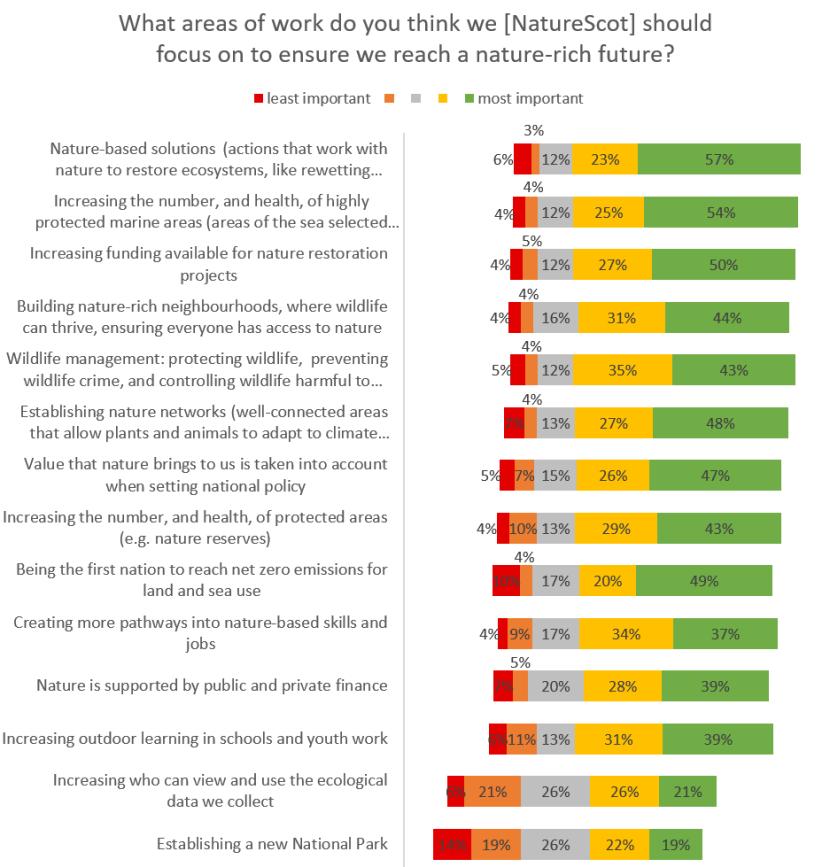
Compound stacked bar-chart listing the corporate plan priorities with the question ‘What areas of work do you think we, NatureScot, should focus on to ensure we reach a nature-rich future? Rank the following from a scale of 1 to 5 with 1 being least important and 5 being most important.’ Data for this graph can be found in table 8 in the annex.
Priorities regarding Nature-based solutions, highly protected marine areas, and funding towards nature restoration, ranked highest with over half of the respondents answering ‘most important’ for the three. Notably, the priority regarding Net zero also ranked highly for ‘most important’ (49%) however scored lower overall due to the proportion of those who deem it less important.
It is worth noting that the top 12 priorities, down to outdoor learning, all have high levels of importance (rated more important (yellow) or most important (green)) (≥67%) with a sudden drop for ecological data (≤47%) and for National Parks (41%). Throughout the survey, ecological data was not discussed in responses suggesting it is not something widely considered by young people in relation to nature. However, National Parks were widely mentioned throughout with comments suggesting that the lower scoring here is due to young people wanting to see nature prevalent in areas wider than just National Parks as well as some commenting that the creation of a new National Park can seem tokenistic if it does not provide any additional protection to nature.
Gaps
The young people were asked to identify if there were any areas of work that they felt were not covered in the presented listed priorities. The gaps that were identified included work that we already undertake, but are not clearly represented in the priorities, as well as work that NatureScot does not necessarily work on but are relevant to nature in general. A full list of themes can be found in Annex 3 - Full survey results with Table 3 listing the most notable areas that were mentioned:
Table 3. Highest occurring themes from respondents when asked “Are there any other things we should focus on to ensure we reach a nature-rich future?” Full list of themes, plus descriptions, found in Annex 3 - Full survey results.
|
Theme |
Incidence |
|---|---|
|
Monitoring and enforcement |
10 |
|
Transparency and partnership working |
6 |
|
(Public) education and behaviour change |
7 |
|
Accessibility (both physical, eg. transport, and issues of Diversity and Inclusion) |
7 |
|
Nature connection |
7 |
|
Species reintroduction/rewilding |
5 |
|
Delivery, accountability, and leading by example |
4 |
|
Urban nature and Green infrastructure |
3 |
|
Waste |
3 |
|
Issues of offsetting |
3 |
‘Monitoring and enforcement’ was mentioned substantially more than any other area of work. These comments included ensuring protected areas are being actively monitored to ensure improvement, having stricter legislation, and using fines to penalise those damaging the environment. Concerns included that there is little point increasing the number of protected areas if there are not the resources in place to ensure they are adequately protected.
Reward people who make efforts to create a better future, and penalise the ones who ruin these efforts.
Put in place fines for actions that harm nature to encourage people to protect it.
I think that the idea of increasing numbers of protected areas on both sea and land is fine so long as there is adequate legislation and funding to support this. Otherwise it becomes a nice-sounding project that isn't actually working efficiently or effectively.
‘Transparency and partnership’ working referred to NatureScot working with government, landowners, Members of Scottish Parliament (MSPs) and councils, businesses, and communities, to ensure these groups are a part of the nature-rich future rather than a barrier to it. It could be argued that this is already a feature of NatureScot’s work but not featured in the priorities strongly enough. Furthermore, this theme included mentions of informing the public about how their land is managed and why decisions are made and showing leadership by being honest and open.
‘(Public) education and behaviour change’, ‘nature connection’, and ‘accessibility and barriers’ covered issues of ensuring everyone has access to, values, and feels the benefits of nature, again with reference to a cultural shift being needed to ensure that everyone feels a part of nature and that people and nature are prioritised over economic profit:
Making sure EVERYONE can access the outdoors
Nature and people need to be the priority, not profit.
It was felt that NatureScot are responsible for facilitating these shifts in culture and mind-set. A suggestion by a respondent revealed the necessity of:
Changing attitudes (through education and exposure) to view humans as part of nature, not separate/more important than it.
“We need to shift our nations identity and what it means to be Scottish. That can be done by introducing children to nature from a very young age, encouraging empathy for others and our environment, teaching them about environmental inequality etc. Some of these things people aren't ready to hear, as it's too much hard work. I assure you that behaviour change is the way forward and that can only be achieved by motivation - people are motivated by what drives them and what they care about.”
Again, diversity and inclusion in relation to being able to access nature and its benefits, was essential for many respondents, exemplified in the following statement:
Improving everyone's ability to enjoy and access nature by minimising barriers associated with disabilities, race, religion, gender etc.
This is reflected in the youth statement review, with other documents contextualising diversity, inclusion, and accessibility as a key concern for achieving environmental justice. In the 2050 Climate Group Youth ask to decision makers, the President of the Black Environment Network is quoted as saying:
“Multicultural voices are key to negotiations for co-created solutions by the Global North and Global South.”
Mentions of urban nature-based solutions and green infrastructure that were prevalent in the 2030 visions, can again be seen here with mentions of the urban environment seen as a gap in the listed priorities. This is possibly due to the urban environment being where many young people either experience nature, or notice a lack there of, or again the want for nature to be prevalent in environments beyond traditional protected areas.
Youth Participation
How strongly do you feel you are able to contribute to Scotland's nature-rich ambition?

Stacked graph showing the answers to ‘How strongly do you feel you are able to contribute to Scotland's nature-rich ambition?’ on a scale of one to five. 1% said ‘1, very unable’, 10% said 2, 41% said 3, 29% said 4, and 19% said ‘5, very able’.
As Scotland’s Nature Agency, NatureScot wants to ensure that everyone, including all young people, feel empowered and able to take action for nature. Of the young people who responded, just under half felt that they were able to contribute to Scotland’s nature rich ambition (48%), with only 19% feeling very able to contribute. 52% felt they were unsure or unable to contribute (Figure 2). This takes into account both their personal confidence in their involvement, as well as their view on the societal system and context in which they act, in working towards a nature-rich future.
Do you feel there are barriers to your involvement in achieving a nature-rich future, and what are they?
To ensure that young people feel able to be involved in a nature-rich future, we must endeavour to do what we can to enable them through removing barriers to involvement. The majority of respondents felt that there were barriers to their involvement (58%), while only a few felt there were no barriers (13%) with the rest answering they don’t know (29%) (Figure 3).
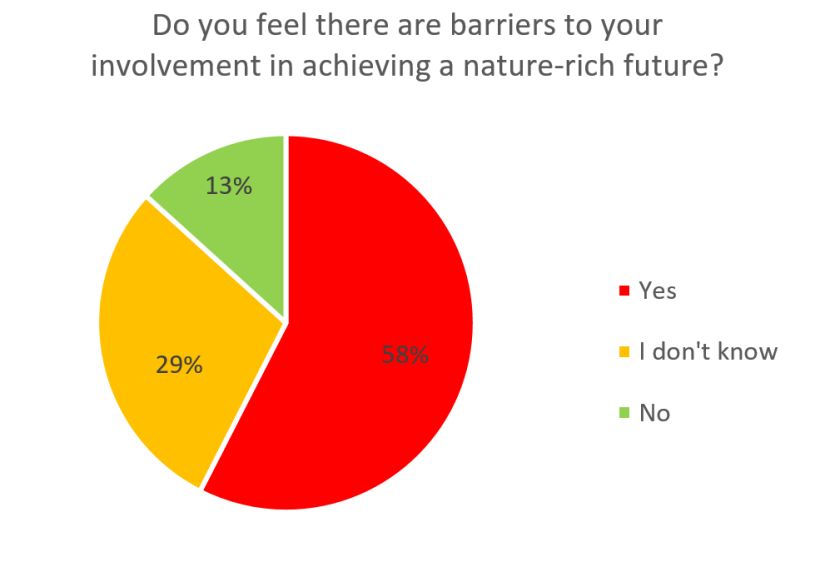
Pie chart showing the answers to ‘Do you feel there are barriers to your involvement in achieving a nature-rich future?’. 58% said yes, 29% said I don’t know, 13% said no.
The young people were asked what the barriers were, with Table 4 listing the most prevalent barriers mentioned:
Table 4. Highest occurring themes from respondents when asked “If you do feel there are barriers to your involvement in achieving a nature-rich future, what are they?” Full list of themes plus descriptions found in Annex 3 - Full survey results.
|
Theme |
Incidence |
|---|---|
|
Barriers to skills and jobs |
19 |
|
Individual effort is not enough |
18 |
|
Finance |
17 |
|
Unaware how to help |
14 |
|
Accessibility (both physical and barriers to diversity and inclusion) |
10 |
|
Lack of youth voice |
8 |
|
Lack of opportunities (outside of employment) |
7 |
|
Time |
6 |
While ‘Creating more pathways into nature-based skills and jobs’ ranked relatively low in the Corporate Plan priorities (see section 2), jobs and careers were mentioned extensively in barriers to participation for young people. Comments included a range of complex issues across the nature-based sector including lack of available jobs, job requirements being too restrictive, lack of career stability, sector reliance on volunteers, and lack of career support. Again, this barrier is experienced across the age range of 11-30 years old:
It's hard to get a job in the nature conservation sector. Volunteering is an option, but hard to do much while working around a full time job.
I'm not from a rich family. My mum is a single parent and is a ranger who works very hard to help the environment but her job is seasonal and she has to go onto benefits every winter. We go hungry because she has to wait so long to get paid and we have to focus on that rather than help nature.
The high incidences of barriers to skills and jobs being mentioned is likely impacted by the respondents being self-selecting and presumably engaged enough in nature that they are looking to it as a career possibility.
Being unaware of how to contribute, as well as lack of opportunities outside of employment, were also extensively mentioned. It is felt that those who aren’t looking to work in the sector, but wish to contribute, struggle to find accessible information on how to do so through both formal volunteering and actions that can be taken at home or in the community. Barriers to getting involved in opportunities and actions included age, geographical location, time and money, and a feeling that individual effort is not enough. Similarly, lack of youth voice, referring to both a lack of opportunities to express it as well as not being listened to when they do, was mentioned:
Because I am younger I am unable to help in ways older people are such as joining proper eco groups instead of my schools one which does help but not as much
I don't know of any opportunities where I, especially at my age, can get involved in these sorts of things locally and nationally.
People just don’t care about individual opinions and there’s not really a way for young people to get there voice heard.
While not specifically identified by respondents as a barrier, evidence of eco-anxiety was noted again, particularly in responses categorised as ‘individual effort not enough’:
Not feeling able to make a difference.
Some respondent’s trust in older generations’ abilities, and particularly in organisations such as NatureScot, is so damaged that they report a distrust or disbelief in the ability for an achievement of a nature-rich future at all. For these people, it is difficult to know how to start imagining what a nature-rich future might be and their role within it.
What can NatureScot do to help remove these barriers?
Finally, the young people were asked what NatureScot could do to help remove the barriers experienced. These were categorised into the following list in Table 5:
Table 5. Highest occurring themes from respondents when asked “What can NatureScot do to help remove these barriers to your involvement?” Theme descriptions found in Annex 3 - Full survey results.
|
Theme |
Incidence |
|---|---|
|
(Public) education and behaviour change |
25 |
|
Jobs and career information |
16 |
|
Opportunities for young people to have a voice |
12 |
|
Creation and promotion of opportunities (outside employment) |
12 |
|
Accessibility and equitable solutions |
9 |
|
Leadership and influence |
9 |
|
Provide guidance on simple actions / sharing ideas |
6 |
|
Improve funding streams |
5 |
|
Public consultation and engagement |
3 |
‘(Public) education and behavioural change’ was the most recorded theme as to what NatureScot could do and was also was identified as one of the key gaps in the current priorities of the Corporate Plan. This focused on the need for appropriate, accessible and engaging information on building a connection with nature across the public and how to take action. These were often in hand with calls for the ‘creation and promotion of opportunities (outside employment)’. This theme of accessibility was generally strong throughout, featuring in many of the themes as well as ‘accessible and equitable solutions’:
Easier access to information/ clearer information on how to help effectively
Encourage environmentally virtuous behaviour (this includes addressing inequalities amongst people). Environmental virtues include equality, respect, temperance etc. It isn't so much what you can do, but what we can all do collectively within communities.
Clear, tailored methods of involvement. I'd love to be more involved but given barriers it would need to be quite small scale - but personally I feel every little helps! For instance, easy to access and simple guidance on incorporating/ recognising nature in everyday life would be great, especially if some of it was tailored to communicating with young kids so I could tell my daughter about it.
‘Jobs and career information’ was again mentioned extensively and includes the creation of jobs in the sector, particularly rangers, issues of pay and career stability and information and education on the roles available. The focus on barriers to jobs and careers, and the suggestions, highlight the need to work with young people to ensure our work on skills and jobs addresses the barriers correctly.
Like some of the barriers, many of the suggestions to overcome them were not age specific, and applied to any member of the public regardless of age. However, providing opportunities for young people to have a voice was mentioned a lot as well. Respondents appreciated the opportunity to feed into the Corporate Plan and felt more opportunities for meaningful engagement were needed.
Make educating people in the protection of nature a priority, and keep releasing surveys so we can have our say.
Get YP (young people) heard!
Establishing plans to include as many people as possible in local areas. To break social norms and do something that is completely unheard of in recent social cooperation to achieve the greatest usage of land in Scotlands modern history.
Conclusion
It is clear that the young people who responded share an ambitious vision for the future of Scotland’s nature. One which all people are very much a part of. A similar picture is evident from the review of youth statements.
Respondents generally agreed that the majority of the draft Corporate Plan 2022-2026 priorities are very important for achieving their 2030 vision, however there were a number of gaps that were identified that need further consideration. The most notable of these gaps were monitoring and enforcement and NatureScot leading the cultural shift needed for increased nature connectedness and behaviour change within society. The majority of young people said that they feel unable to contribute to this nature-rich future, despite wanting to, because of a number of barriers preventing them from doing so, such as: issues around jobs and opportunities for meaningful engagement, and accessibility including finances, time, and other diversity and inclusion aspects.
While delivered to input into the drafting of NatureScot’s Corporate Plan 2022-2026, the findings of this survey, particularly the qualitative input from young people, will also be of use to wider work across both NatureScot and the nature-based sector. The survey has also acted as a pilot and stimulus to developing a larger and more representative national survey of young people that will allow more in depth exploration of the perceptions, attitudes and behaviours of young people.
References
Decent Jobs for Youth., and Generation Unlimited. 2020. Generation Unlimited and Decent Jobs for Youth.
Hickman, C., Marks, E., Pihkala, P., Clayton, S., Lewandowski, E.R., Mayall, E.E., Wray, B., Mellor, C. and van Susteren, L., 2021. Young people's voices on climate anxiety, government betrayal and moral injury: A global phenomenon. Government Betrayal and Moral Injury: A Global Phenomenon.
NatureScot. 2021. NatureScot Equality Report 2019-2021.
Sax, L.J., Gilmartin, S.K. and Bryant, A.N., 2003. Assessing response rates and nonresponse bias in web and paper surveys. Research in higher education, 44(4), pp.409-432.
Scottish Government. 2017. Public Attitudes to Young People in Scotland.
Smith, W. G. 2008. Does Gender Influence Online Survey Participation? A Record-Linkage Analysis of University Faculty Online Survey Response Behavior. Online Submission: ResearchGate.
UN Convention on Biological Diversity (CBD) Secretariat. 2021. First Draft of the Post-2020 Global Biodiversity Framework.
Annex 1 - Youth statement review
Youth statements reviewed:
- Scottish Wildlife Trust Young Leaders Manifesto (Scotland specific)
- Scottish Youth Climate Summit declaration (biodiversity section) (Scotland specific)
- 2050 Climate Group Youth ask to decision makers (Scotland specific)
- EUROPARC Youth Manifesto (Europe)
- YOUNGO and GBYN Nature-based solutions Youth Position (Global)
- Youth #ForNature to #StopTheSame Manifesto (Global)
Table 6. All themes that appeared in the youth statements and the number of times that theme appeared.
|
Theme |
Incidence |
|---|---|
|
Intersectionality and environmental justice (inc. diversity, solidarity, equality, rights, environmental justice and representation) |
45 |
|
Collaboration, collective action |
22 |
|
Accountability and transparency |
21 |
|
Funding, finance, and spending |
18 |
|
Indigenous and local communities and knowledges |
18 |
|
Biodiversity |
15 |
|
Education |
15 |
|
Creativity and innovation |
13 |
|
Community self-sufficiency, action, and leadership |
11 |
|
Nature connectedness |
10 |
|
Intergenerational collaboration and legacy |
10 |
|
Youth leadership |
10 |
|
Immediate action |
10 |
|
Government action |
10 |
|
Climate change |
10 |
|
Urban green space and infrastructure/GI |
10 |
|
Youth voice |
9 |
|
Individual and collective responsibility |
9 |
|
Decision-making power |
9 |
|
Access and accessibility |
9 |
|
Agriculture and food |
9 |
|
Nature-based solutions |
8 |
|
Employment, jobs, skills, and training |
8 |
|
Sustainability, sustainable management |
8 |
|
Active travel and public transport |
8 |
|
Healthy environment |
8 |
|
Marine areas and habitats |
7 |
|
Rural communities |
7 |
|
Health and wellbeing |
6 |
|
Engagement (digital and in person) |
6 |
|
Energy |
6 |
|
Policy |
5 |
|
Protected areas and habitats |
5 |
|
Nature and heritage/culture |
5 |
|
Economic restructuring, circular economy |
5 |
|
Culture shift |
5 |
|
Eco-anxiety and solastalgia |
5 |
|
Mitigation and adaptation |
5 |
|
Women |
4 |
|
Waste |
4 |
|
Pollution |
4 |
|
Higher education and industry |
4 |
|
Green recovery |
3 |
|
Greenwashing |
3 |
|
Loss and damage |
2 |
|
Interdisciplinarity |
2 |
|
Concerns about offsetting reliance |
2 |
|
Commodification of nature |
2 |
|
Decarbonisation |
2 |
|
‘Youthwashing’ and performativity |
1 |
Annex 2 - Survey respondents’ demographics
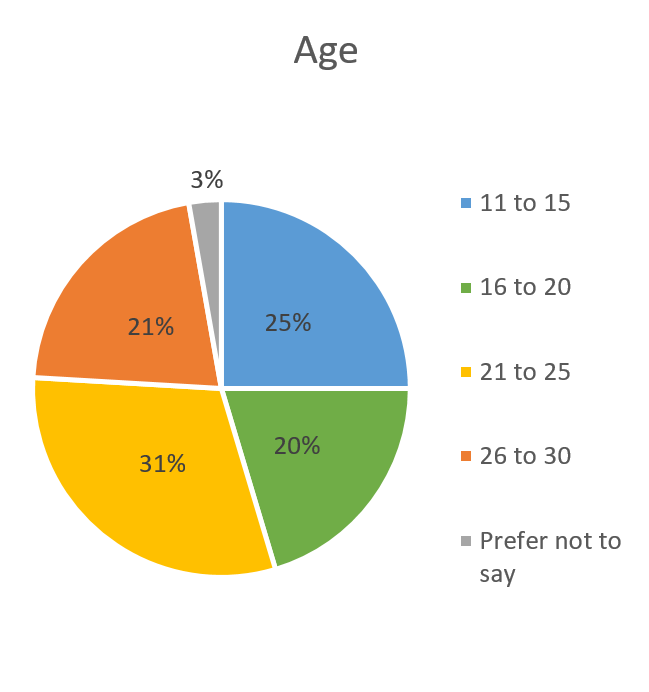
Pie chart showing the age of respondents. 25% were aged 11 to 15, 20% were aged 16 to 20, 31% were aged 21 to 25, 21% were aged 26 to 30 and 3% preferred not to say.
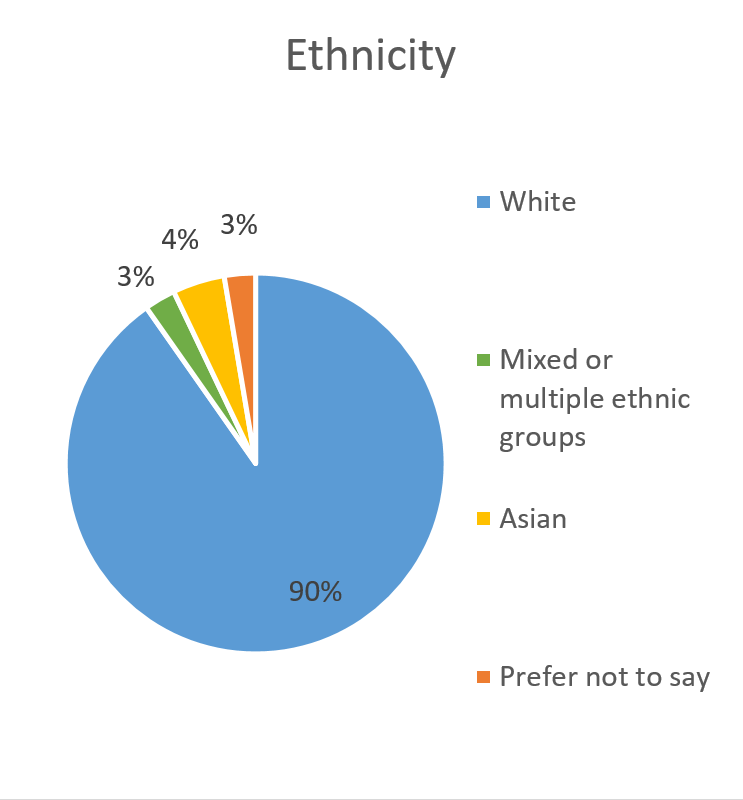
Pie chart showing the ethnicity of respondents. 90% were White, 4% Asian, 3% mixed or multiple ethnic groups, and 3% preferred not to say.
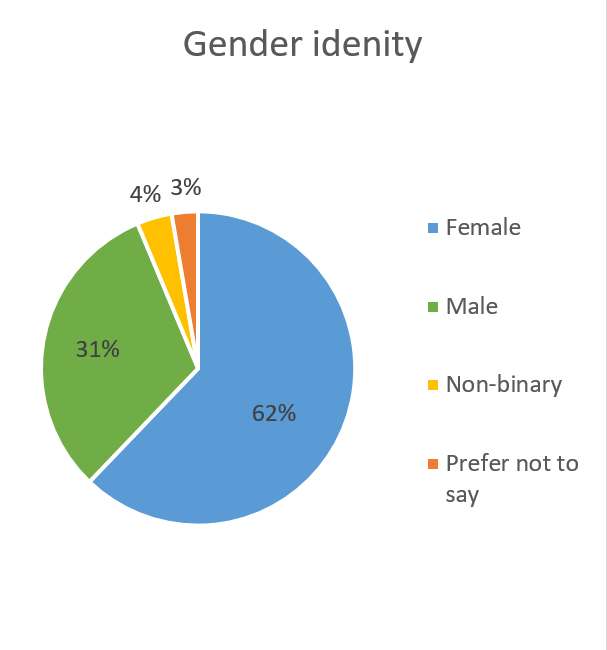
Pie chart showing the gender identity of respondents. 63% were female, 31% male, 4% non-binary and 3% preferred not to say.
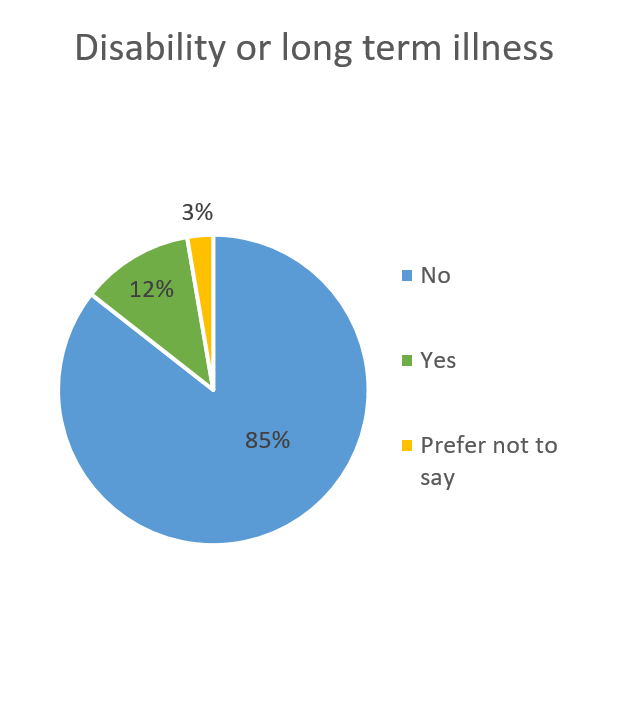
Pie chart showing whether respondents reported a disability or long term illness. 95% said no, 13% said yes, 3% preferred not to say.
Geographic location
There were respondents from every district is Scotland except for the Outer Hebrides and the Shetland Islands.
Totals:
13 AB = Aberdeen
2 DD = Dundee, Angus
3 DG = Dumfries and Galloway
25 EH = Edinburgh, Midlothian
11 FK = Falkirk, Stirlingshire
12 G = Glasgow, Lanarkshire
0 HS = Isle of Lewis, Outer Hebrides
12 IV = Inverness
5 KA = Kilmarnock and Ayr, Ayrshire
3 KW = Kirkwall, Caithness
3 KY = Kirkcaldy, Fife
2 ML = Motherwell, Lanarkshire
4 PA = Paisley, Renfrewshire
9 PH = Perth, Perthshire
1 TD = Galashiels, Selkirkshire
0 ZE = Shetland Islands
7 prefer not to say/not recordable
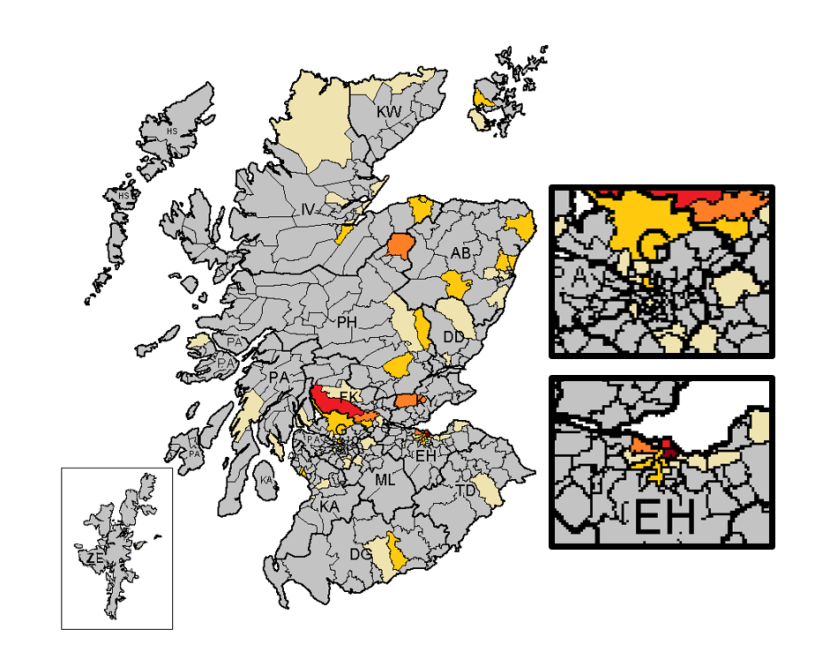
Map of Scotland's districts showing where respondents were located. Two zoomed in maps showing the areas of Glasgow and Edinburgh in more detail. Areas with the highest number of respondents include EH7. Areas with slightly fewer respondents include EH6 and FK8. Areas with fewer number of respondents include EH4 and PH26. Areas with fewer number of respondents include AB21, AB34, AB42, G63, IV3, IV30, IV31, EH8, EH11, EH39, KA21, DG1, PH1, PH11, KY13. Areas with the fewest number of respondents include AB15, AB32, AB39, FK17, FK2, G3, G13, G20, G53, G61, G74, G75, G81, G84, IV 1, IV10, IV11, IV16, IV20, IV27, EH3, EH8, EH10, EH12, EH15, EH16, EH21, EH33, KA1, KA20, KA8, PH10, DD9, TD5, PA20, PA31, PA75, KW16, ML3, DD4, KW14. There were no respondents from all other districts.
Annex 3 - Full survey results
In your opinion, what should Scotland's nature look like in 2030?
Table 7. All themes that were recorded and the number of times that theme appeared.
|
Theme |
Description |
Incidence |
|---|---|---|
|
Rewilding |
Both making spaces wilder and restoring nature back to previous states - with and leading to abundant native species |
39 |
|
Increased diversity in biodiversity |
Particularly noting more diversity in the wildlife we have |
26 |
|
General increase in nature |
- |
25 |
|
Cultural shift |
A move to valuing, respecting, appreciating and caring for nature; focus on nature connection/ coexistence between humans, plants, and animals |
22 |
|
Recovering and being restored |
Restoration of ecosystems and habitats |
18 |
|
Accessible and available |
- |
18 |
|
Species re-introduction |
Including mentions of re-introducing lost species (animals and plants) including carnivores |
15 |
|
Cleaner |
e.g. less littered, cleaner air |
13 |
|
Nature-based solutions |
Including peatlands, wetlands, forests and woodlands |
13 |
|
Urban nature and GI |
Mentions of nature in towns and cities |
12 |
|
Climate change |
Making the connection between nature and climate change |
11 |
|
Range of natural spaces |
Eg. nature not being restricted to protected/ designated sites but found everywhere |
11 |
|
Prioritised in business, policy and funding |
- |
11 |
|
Protected areas and protected species |
- |
10 |
|
Healthy (people and planet) |
- |
8 |
|
Sustainable, resilient, and self-sufficient |
- |
8 |
|
(Educated on) being stewards of nature/looking after nature |
- |
7 |
|
Marine health |
- |
7 |
|
Agriculture |
Particularly shifts in agricultural techniques |
7 |
|
Mindful wildlife management |
- |
5 |
|
Fairness, equality, justice, indigeneity |
- |
5 |
|
Responsive, effective, and enforced land management policy |
- |
5 |
|
Prevent over-urbanisation |
- |
5 |
|
Aesthetics |
- |
3 |
|
Participatory monitoring/ community involvement |
- |
3 |
|
Jobs |
- |
3 |
|
National parks and nature reserves |
- |
2 |
|
Scottish leadership |
- |
2 |
|
Renewables |
Including balancing with NbS |
2 |
|
Nature-based interactive activities |
- |
2 |
|
Innovative technologies |
- |
1 |
What areas of work do you think we should focus on to ensure we reach a nature-rich future? Rank the following from a scale of 1 to 5 with 1 being least important and 5 being most important.
Table 8. Ranking of the priorities explored in the development of the Corporate Plan 2022-2026 in order of importance including their average score.
|
Corporate Plan priority |
1 |
2 |
3 |
4 |
5 |
Av |
|---|---|---|---|---|---|---|
|
Nature-based solutions (actions that work with nature to restore ecosystems, like rewetting peatlands and green roofs in cities) |
7 |
3 |
13 |
26 |
64 |
4.21 |
|
Increasing the number, and health, of highly protected marine areas (areas of the sea selected for the protection and recovery of marine ecosystems) |
5 |
5 |
14 |
28 |
61 |
4.19 |
|
Increasing funding available for nature restoration projects |
5 |
6 |
14 |
31 |
57 |
4.14 |
|
Building nature-rich neighbourhoods, where wildlife can thrive, ensuring everyone has access to nature |
5 |
5 |
18 |
35 |
50 |
4.06 |
|
Wildlife management: protecting wildlife, preventing wildlife crime, and controlling wildlife harmful to the environment |
6 |
5 |
14 |
39 |
49 |
4.06 |
|
Establishing nature networks (well-connected areas that allow plants and animals to adapt to climate change) |
8 |
5 |
15 |
31 |
54 |
4.04 |
|
Value that nature brings to us is taken into account when setting national policy |
6 |
8 |
17 |
29 |
53 |
4.02 |
|
Increasing the number, and health, of protected areas (e.g. nature reserves) |
5 |
11 |
15 |
33 |
49 |
3.97 |
|
Being the first nation to reach net zero emissions for land and sea use |
11 |
5 |
19 |
23 |
55 |
3.94 |
|
Creating more pathways into nature-based skills and jobs |
4 |
10 |
19 |
38 |
42 |
3.92 |
|
Nature is supported by public and private finance |
8 |
6 |
23 |
32 |
44 |
3.87 |
|
Increasing outdoor learning in schools and youth work |
7 |
12 |
15 |
35 |
44 |
3.86 |
|
Increasing who can view and use the ecological data we collect |
7 |
24 |
29 |
29 |
24 |
3.35 |
|
Establishing a new National Park |
16 |
21 |
29 |
25 |
22 |
3.14 |
Are there any other things we should focus on to ensure we reach a nature-rich future? If yes, please tell us what they are.
Table 9. All themes that were recorded and the number of times that theme appeared.
|
Theme |
Description |
Incidence |
|---|---|---|
|
Monitoring and enforcement |
This including ensuring that protected areas were actually being protected and improving as well as penalising those who damage the environment. Laws, legislation, fining. |
10 |
|
transparency and partnership working |
Working with government, stakeholders, and communities as well as informing the public about how their land is managed and why decisions are made. |
6 |
|
(Public) education and behaviour change |
Includes awareness raising of the importance of nature and what people can do to help |
7 |
|
Accessibility |
Includes both physical such as transport and barriers to diversity and inclusion |
7 |
|
Nature connection |
People building a relationship with nature, valuing nature and experiencing the benefits |
7 |
|
Species reintroduction/rewilding |
|
5 |
|
Delivery, accountability, and leading by example |
Ensuring NatureScot delivers on targets and actions and ensuring we are ‘nature-rich’ ourselves |
4 |
|
Urban environment and Green infrastructure |
|
3 |
|
Waste |
Particular focus on plastics and litter |
3 |
|
Issues of offsetting |
Concerning by using offsetting for emissions and impacts on biodiversity, including the communication and ‘trading’ of nature |
3 |
|
Renewables |
- |
2 |
|
Agriculture |
- |
2 |
|
Woodland and grassland management |
- |
2 |
|
Funding |
- |
2 |
|
Soils and insects |
- |
2 |
|
Marine |
- |
1 |
|
(school) education |
- |
1 |
|
Fossil fuel |
- |
1 |
|
Rangers |
- |
1 |
|
Youth decision making |
- |
1 |
|
Urgency |
- |
1 |
On a scale of 1 to 5, where 1 indicates very unable and 5 indicates very able, how strongly do you feel you are able to contribute to Scotland's nature-rich ambition?
Table 10. The number and percentage of respondents who reported how strongly they feel they are able to contribute to Scotland's nature-rich ambition from 1 to 5.
|
Answer |
Respondents |
Percentage |
|---|---|---|
|
1 – Very unable |
1 |
1% |
|
2 |
11 |
10% |
|
3 |
46 |
41% |
|
4 |
33 |
29% |
|
5 – Very able |
22 |
19% |
|
Total |
113 |
100% |
Do you feel there are barriers to your involvement in achieving a nature-rich future?
Table 11. The number and percentage of respondents who reported how strongly they feel they are able to contribute to Scotland's nature-rich ambition from 1 to 5.
|
Answer |
Respondents |
Percentage |
|---|---|---|
|
Yes |
65 |
58% |
|
No |
15 |
13% |
|
I don’t know |
33 |
29% |
|
Total |
113 |
100% |
Answer’s to how strongly do you feel you are able to contribute to Scotland's nature-rich ambition (where 1 indicates very unable and 5 indicates very able) compared to whether they feel there are barriers to their involvement.
Table 12. Percentage of those who reported how strongly they feel they are able to contribute to Scotland's nature-rich ambition compared to whether they felt there are barriers to their involvement.
|
Answer |
No |
I don’t know |
Yes |
|---|---|---|---|
|
5 |
7% |
12% |
26% |
|
4 |
27% |
30% |
29% |
|
3 |
33% |
48% |
38% |
|
2 |
27% |
9% |
6% |
|
1 |
7% |
0% |
0% |
If you do feel there are barriers to your involvement in achieving a nature-rich future, what are they?
Table 13. All themes that were recorded and the number of times that theme appeared.
|
Theme |
Description |
Incidence |
|---|---|---|
|
Barriers to skills and jobs |
Barriers to skills and jobs broken down further:
|
19 |
|
Individual effort is not enough |
Including mentions of responsibility being on those in decision-making positions/ with power eg. gov/council/landowners/business |
18 |
|
Finance |
Including both individuals lacking the funds to partake, opportunities costing money, there not being enough funding in the sector |
17 |
|
Unaware how to help |
|
14 |
|
Accessibility |
Including lack of public transport (4) |
10 |
|
Lack of youth voice |
Including lack of opportunities for young people to be involved and the young voice not being listened to when they are |
8 |
|
Lack of opportunities |
opportunities outside of employment including access to land |
7 |
|
Time |
- |
6 |
|
Lack of resources |
- |
2 |
|
Peer pressure |
- |
1 |
What can NatureScot do to help remove these barriers to your involvement?
Table 14. All themes that were recorded and the number of times that theme appeared.
|
Theme |
Description |
Incidence |
|---|---|---|
|
(Public) education and behaviour change |
Accessible information on how to take action including general awareness raising in education and media |
25 |
|
Jobs and career info |
Includes the creations of jobs in the sector, particularly rangers, issues of pay and career stability, and information and education on the roles available. |
16 |
|
Opportunities for young people to have a voice |
- |
12 |
|
Creation and promotion of opportunities |
Includes all opportunities that are not employment (eg. nature-based locations, activities and volunteering) |
12 |
|
Accessibility and equitable solutions |
Includes removing barriers to do with transport, finance, housing |
9 |
|
Leadership and influence |
Using our influence to encourage SG, councils, environmental organisations, business to do better and be bolder |
9 |
|
Provide guidance on simple actions / sharing ideas |
- |
6 |
|
Improve funding streams |
Improve funding for projects, community groups and sector staff (including amount of funding and accessibility) |
5 |
|
Public consultation and engagement |
- |
3 |
Disclaimer: Scottish Natural Heritage (SNH) has changed its name to NatureScot as of the 24th August 2020.
At the time of publishing, this document may still refer to Scottish Natural Heritage (SNH) and include the original branding. It may also contain broken links to the old domain.
If you have any issues accessing this document please contact us via our feedback form.
